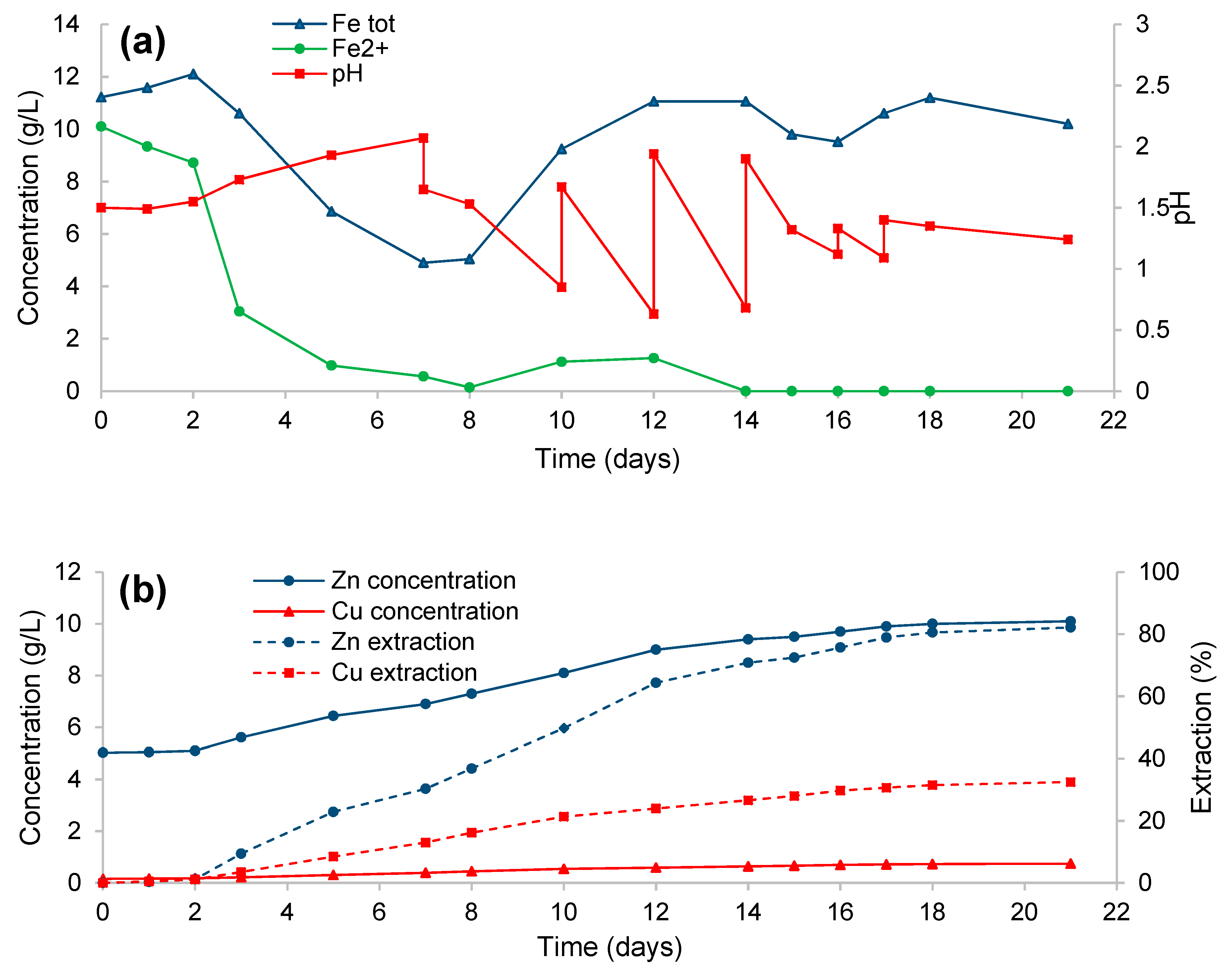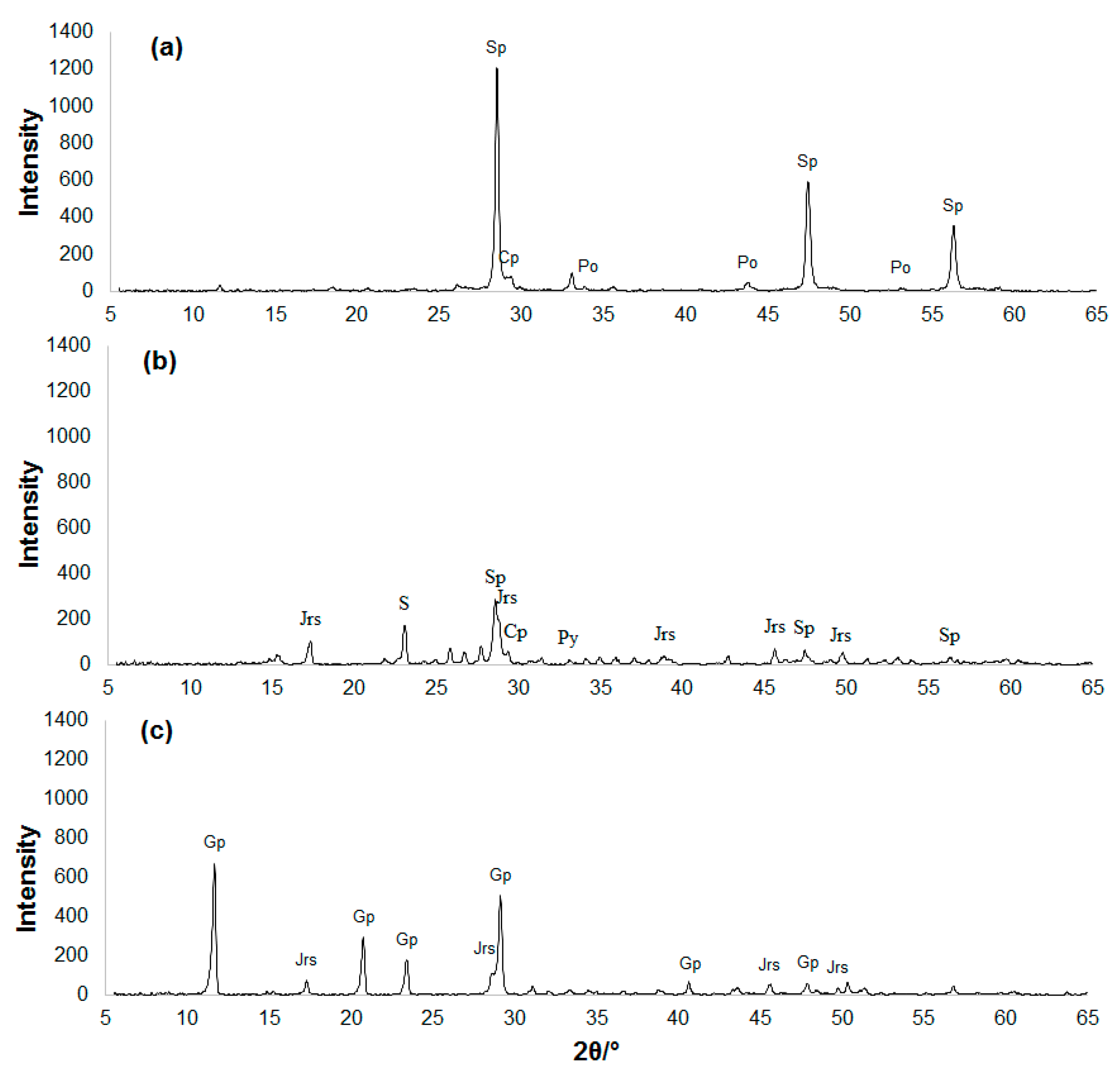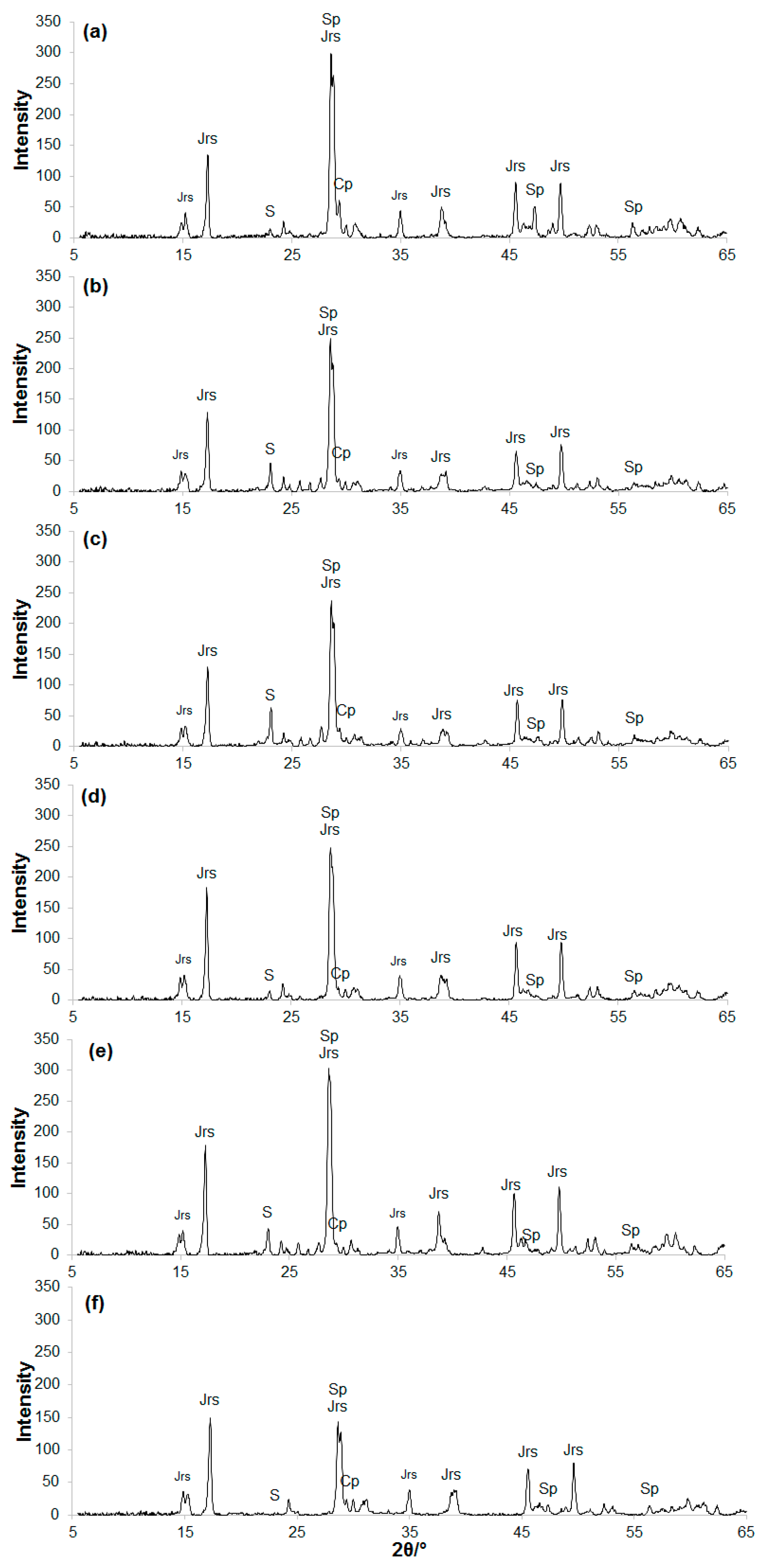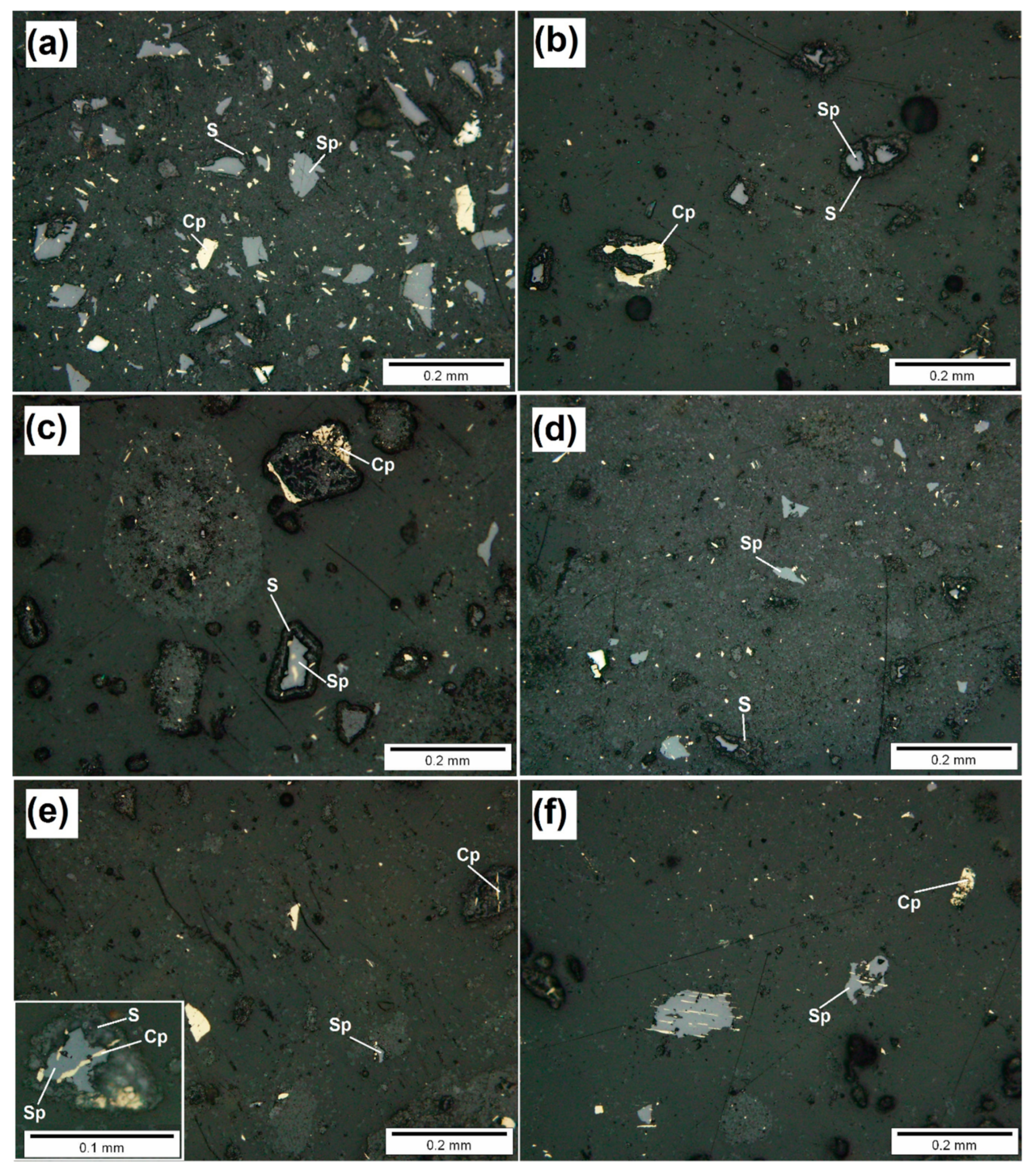Distinct Roles of Acidophiles in Complete Oxidation of High-Sulfur Ferric Leach Product of Zinc Sulfide Concentrate
Abstract
1. Introduction
2. Materials and Methods
2.1. Materials
2.2. Biooxidation Experiments
2.3. Analysis of Microbial Community Structure
2.3.1. 16S rRNA V3-V4 Amplicon Metabarcoding
2.3.2. Isolation of Pure Cultures and Taxonomic Research
2.4. Analytical Methods
3. Results and Discussion
3.1. Oxidation by Microbial Community in Bioreactor
3.2. Oxidation by Microorganisms in Flasks
4. Conclusions
- the final oxidation levels of sphalerite and chalcopyrite were 99 and 69%, respectively (compared to the original sulfide concentrate), which indicates the effectiveness of a two-step process for processing low-grade zinc concentrates;
- the biooxidation residue was mainly composed of jarosite and gypsum and contained 0.52% of zinc, 0.55% of copper, and 0.40% of elemental sulfur; therefore, it can be considered dump waste that is inert under aerobic conditions;
- the developed microbial community consisted of a sulfur-oxidizing bacterium A. caldus, an iron-oxidizing lithoautotroph L. ferriphilum, an iron-oxidizing mixotroph F. acidiphilum, iron- and sulfur-oxidizing mixotrophs S. thermotolerans and S. thermosulfidooxidans, as well as a heteroorganotroph Cuniculiplasma sp.;
- pure cultures of A. caldus, L. ferriphilum, and S. thermosulfidooxidans, isolated from the acidophilic microbial community, as well as F. acidiphilum YT, oxidized sulfide minerals and elemental sulfur of the leach residue at lower efficiency than a mixture of these microorganisms;
- a mixture of A. caldus and L. ferriphilum oxidized elemental sulfur in the leach residue at a lower level than a pure culture of A. caldus;
- the crucial roles in the oxidation of sulfide minerals and sulfur of the ferric leach residue belonged to F. acidiphilum and A. caldus, respectively;
- sphalerite oxidation is determined not only by the amount of reaction products on the surface of the mineral or in the biooxidation residue, but also by their qualitative characteristics associated with the species and strain composition.
Author Contributions
Funding
Conflicts of Interest
References
- Abkhoshk, E.; Jorjani, E.; Al-Harahsheh, M.S.; Rashchi, F.; Naazeri, M. Review of the hydrometallurgical processing of non-sulfide zinc ores. Hydrometallurgy 2014, 149, 153–167. [Google Scholar] [CrossRef]
- Ejtemaei, M.; Gharabaghi, M.; Irannajad, M. A review of zinc oxide mineral beneficiation using flotation method. Adv. Colloid Interface Sci. 2014, 206, 68–78. [Google Scholar] [CrossRef] [PubMed]
- Boulamanti, A.; Moya, J.A. Production costs of the non-ferrous metals in the EU and other countries: Copper and zinc. Resour. Policy 2016, 49, 112–118. [Google Scholar] [CrossRef]
- Balarini, J.C.; Polli, L.O.; Miranda, T.L.S.; Castro, R.M.Z.; Salum, A. Importance of roasted sulphide concentrates characterization in the hydrometallurgical extraction of zinc. Miner. Eng. 2008, 21, 100–110. [Google Scholar] [CrossRef]
- Zhang, S.; Yan, L.; Xing, W.; Chen, P.; Zhang, Y.; Wang, W. Acidithiobacillus ferrooxidans and its potential application. Extremophiles 2018, 22, 563–579. [Google Scholar] [CrossRef]
- Watling, H. Microbiological advances in biohydrometallurgy. Minerals 2016, 6, 49. [Google Scholar] [CrossRef]
- Sethurajan, M.; van Hullebusch, E.D.; Nancharaiah, Y.V. Biotechnology in the management and resource recovery from metal bearing solid wastes: Recent advances. J. Env. Manag. 2018, 211, 138–153. [Google Scholar] [CrossRef]
- Fomchenko, N.V.; Muravyov, M.I. Two-step biohydrometallurgical technology for modernization of processing of sulfidic copper-zinc products. Hydrometallurgy 2017, 174, 116–122. [Google Scholar] [CrossRef]
- Fomchenko, N.V.; Muravyov, M.I. Two-step biohydrometallurgical technology of copper-zinc concentrate processing as an opportunity to reduce negative impacts on the environment. J. Environ. Manag. 2018, 226, 270–277. [Google Scholar] [CrossRef]
- Nikkhou, F.; Xia, F.; Deditius, A.P. Variable surface passivation during direct leaching of sphalerite by ferric sulfate, ferric chloride, and ferric nitrate in a citrate medium. Hydrometallurgy 2019, 188, 201–215. [Google Scholar] [CrossRef]
- Lorenzo-Tallafigo, J.; Iglesias-Gonzalez, N.; Romero, R.; Mazuelos, A.; Carranza, F. Ferric leaching of the sphalerite contained in a bulk concentrate: kinetic study. Miner. Eng. 2018, 125, 50–59. [Google Scholar] [CrossRef]
- Muravyov, M.I.; Fomchenko, N.V. Ferric leaching of low-grade zinc concentrate with a biologically produced solution. Appl. Biochem. Microbiol. 2019, 55, 414–419. [Google Scholar] [CrossRef]
- Mahmoud, A.; Cezac, P.; Hoadley, A.F.A.; Contamine, F.; D’Hugues, P. A review of sulfide minerals microbially assisted leaching in stirred tank reactors. Int. Biodeterior. Biodegrad. 2017, 119, 118–146. [Google Scholar] [CrossRef]
- Kondrat’eva, T.F.; Pivovarova, T.A.; Tsaplina, I.A.; Fomchenko, N.V.; Zhuravleva, A.E.; Murav’ev, M.I.; Melamud, V.S.; Bulayev, A.G. Diversity of the communities of acidophilic chemolithotrophic microorganisms in natural and technogenic ecosystems. Microbiology 2012, 81, 1–24. [Google Scholar] [CrossRef]
- Silverman, M.P.; Lundgren, D.G. Studies on the chemoautotrophic iron bacteria Ferrobacillus ferrooxidans. An improved medium and harvesting procedure for securing high yields. J. Bacteriol. 1959, 77, 642–647. [Google Scholar] [CrossRef] [PubMed]
- Muravyov, M.I.; Melamud, V.S.; Fomchenko, N.V. Biooxidation of high-sulfur ferric leaching products of low-grade zinc concentrate. Microbiology 2020, 89, 174–181. [Google Scholar] [CrossRef]
- Fadrosh, D.W.; Ma, B.; Gajer, P.; Sengamalay, N.; Ott, S.; Brotman, R.M.; Ravel, J. An improved dual-indexing approach for multiplexed 16S rRNA gene sequencing on the Illumina MiSeq platform. Microbiome 2014, 2, 6. [Google Scholar] [CrossRef]
- Caporaso, J.G.; Kuczynski, J.; Stombaugh, J.; Bittinger, K.; Bushman, F.D.; Costello, E.K.; Fierer, N.; Pẽa, A.G.; Goodrich, J.K.; Gordon, J.I.; et al. QIIME allows analysis of high-throughput community sequencing data. Nat. Methods 2010, 7, 335. [Google Scholar] [CrossRef]
- Quast, C.; Pruesse, E.; Yilmaz, P.; Gerken, J.; Schweer, T.; Yarza, P.; Peplies, J.; Glöckneret, F.O. The SILVA ribosomal RNA gene database project: improved data processing and web-based tools. Nucleic Acids Res. 2012, 41, D590–D596. [Google Scholar] [CrossRef]
- Melamud, V.S.; Pivovarova, T.A. Specific features of the growth of the type strain of Sulfobacillus thermosulfidooxidans in medium 9K. Appl. Biochem. Microbiol. 1998, 34, 281–286. [Google Scholar]
- Panyushkina, A.E.; Tsaplina, I.A.; Kondrat’eva, T.F.; Belyi, A.V.; Bulaev, A.G. Physiological and morphological characteristics of acidophilic bacteria Leptospirillum ferriphilum and Acidithiobacillus thiooxidans, members of the chemolithotrophic microbial consortium. Microbiology 2018, 87, 326–338. [Google Scholar] [CrossRef]
- Woods, J.T.; Mellon, M.G. Thiocyanate method for iron: A spectrophotometric study. Ind. Eng. Chem. Anal. Ed. 1941, 13, 551–554. [Google Scholar] [CrossRef]
- Filippova, N.A. Phazovy analiz rud i produktov ikh pererabotki; Khimiya: Moscow, USSR, 1975. (In Russian) [Google Scholar]
- Ostroumov, E.A.; Ivanov-Emin, B.N. Metody opredeleniya sery; Mosgeoltekhizdat: Moscow, USSR, 1945. (In Russian) [Google Scholar]
- Deveci, H.; Akcil, A.; Alp, I. Bioleaching of complex zinc sulphides using mesophilic and thermophilic bacteria: comparative importance of pH and iron. Hydrometallurgy 2004, 73, 293–303. [Google Scholar] [CrossRef]
- Breed, A.W.; Hansford, G.S. Effect of pH on ferrous-iron oxidation kinetics of Leptospirillum ferrooxidans in continuous culture. Biochem. Eng. J. 1999, 3, 193–201. [Google Scholar] [CrossRef]
- Golyshina, O.V.; Pivovarova, T.A.; Karavaiko, G.I.; Kondrat’eva, T.F.; Moore, E.R.; Abraham, W.R.; Lansdorf, H.; Timmis, K.; Yakimov, M.M.; Golyshin, P.N. Ferroplasma acidiphilum gen. nov., sp. nov, an acidophilic, autotrophic, ferrous-iron-oxidizing cell-wall-lacking, mesophilic member of the Ferroplasmaceae fam. nov., comprising a distinct lineage of the Archaea. Int. J. Syst. Bacteriol. 2000, 50, 997–1006. [Google Scholar] [CrossRef]
- Bogdanova, T.I.; Tsaplina, I.A.; Kondrat’eva, T.F.; Duda, V.I.; Suzina, N.E.; Melamud, V.S.; Tourova, T.P.; Karavaiko, G.I. Sulfobacillus thermotolerans sp. nov., a thermotolerant, chemolithotrophic bacterium. Int. J. Syst. Evol. Microbiol. 2006, 56, 1039–1042. [Google Scholar] [CrossRef]
- Muravyov, M. Bioprocessing of mine waste: effects of process conditions. Chem. Pap. 2019, 73, 3075–3083. [Google Scholar] [CrossRef]
- Estrada-De los Santos, F.; Rivera-Santillán, R.E.; Talavera-Ortega, M.; Bautista, F. Catalytic and galvanic effects of pyrite on ferric leaching of sphalerite. Hydrometallurgy 2016, 163, 167–175. [Google Scholar] [CrossRef]
- Arpalahti, A.; Lundström, M. The leaching behavior of minerals from a pyrrhotite-rich pentlandite ore during heap leaching. Min. Eng. 2018, 119, 116–125. [Google Scholar] [CrossRef]
- Mehta, A.P.; Murr, L.E. Fundamental studies of the contribution of galvanic interaction to acid-bacterial leaching of mixed metal sulfides. Hydrometallurgy 1983, 9, 235–256. [Google Scholar] [CrossRef]
- Zhao, H.; Zhang, Y.; Sun, M.; Ou, P.; Zhang, Y.; Liao, R.; Qiu, G. Catalytic mechanism of silver in the oxidative dissolution process of chalcopyrite: Experiment and DFT calculation. Hydrometallurgy 2019, 187, 18–29. [Google Scholar] [CrossRef]
- Tanne, C.K.; Schippers, A. Electrochemical investigation of chalcopyrite (bio)leaching residues. Hydrometallurgy 2019, 187, 8–17. [Google Scholar] [CrossRef]
- Hedrich, S.; Joulian, C.; Graupner, T.; Schippers, A.; Guézennec, A.G. Enhanced chalcopyrite dissolution in stirred tank reactors by temperature increase during bioleaching. Hydrometallurgy 2018, 179, 125–131. [Google Scholar] [CrossRef]
- Esmailbagi, M.R.; Schaffie, M.; Kamyabi, A.; Ranjbar, M. Microbial assisted galvanic leaching of chalcopyrite concentrate in continuously stirred bioreactors. Hydrometallurgy 2018, 180, 139–143. [Google Scholar] [CrossRef]
- Khoshkhoo, M.; Dopson, M.; Engström, F.; Sandström, Å. New insights into the influence of redox potential on chalcopyrite leaching behavior. Miner. Eng. 2017, 100, 9–16. [Google Scholar] [CrossRef]
- Golyshina, O.V.; Lünsdorf, H.; Kublanov, I.V.; Goldenstein, N.I.; Hinrichs, K.U.; Golyshin, P.N. The novel extremely acidophilic, cell-wall-deficient archaeon Cuniculiplasma divulgatum gen. nov., sp. nov. represents a new family, Cuniculiplasmataceae fam. nov., of the order. Int. J. Syst. Evol. Microbiol 2016, 66, 332–340. [Google Scholar] [CrossRef]
- Johnson, D.B.; Roberto, F.F. Heterotrophic acidophiles and their roles in the bioleaching of sulfide minerals. In Biomining. Biotechnology Intelligence Unit; Rawlings, D.E., Ed.; Springer: Berlin/Heidelberg, Germany, 1997; pp. 259–279. [Google Scholar]
- Karavaiko, G.I.; Krasil’nikova, E.N.; Tsaplina, I.A.; Bogdanova, T.I.; Zakharchuk, L.M. Growth and carbohydrate metabolism of sulfobacilli. Microbiol. 2001, 70, 245–250. [Google Scholar] [CrossRef]
- Zhuravleva, A.E.; Ismailov, A.D.; Tsaplina, I.A. Electron donors at oxidative phosphorylation in bacteria of the genus Sulfobacillus. Microbiol. 2009, 78, 811–814. [Google Scholar] [CrossRef]
- Ñancucheo, I.; Johnson, D.B. Production of glycolic acid by chemolithotrophic iron-and sulfur-oxidizing bacteria and its role in delineating and sustaining acidophilic sulfide mineral-oxidizing consortia. Appl. Environ. Microbiol. 2010, 76, 461–467. [Google Scholar] [CrossRef]
- Zhang, L.; Zhou, W.; Li, K.; Mao, F.; Wan, L.; Chen, X.; Zhou, H.; Qiu, G. Synergetic effects of Ferroplasma thermophilum in enhancement of copper concentrate bioleaching by Acidithiobacillus caldus and Leptospirillum ferriphilum. Biochem. Eng. J. 2015, 93, 142–150. [Google Scholar] [CrossRef]
- Tsaplina, I.A.; Zhuravleva, A.E.; Egorova, M.A.; Bogdanova, T.I.; Krasil’nikova, E.N.; Zakharchuk, L.M.; Kondrat’eva, T.F. Response to oxygen limitation in bacteria of the genus Sulfobacillus. Microbiol. 2010, 79, 13–22. [Google Scholar] [CrossRef]
- Panyushkina, A.E.; Babenko, V.V.; Nikitina, A.S.; Selezneva, O.V.; Tsaplina, I.A.; Letarova, M.A.; Kostryukova, E.S.; Letarov, A.V. Sulfobacillus thermotolerans: new insights into resistance and metabolic capacities of acidophilic chemolithotrophs. Sci. Rep. 2019, 9, 15069. [Google Scholar] [CrossRef] [PubMed]
- Li, Q.; Tian, Y.; Fu, X.; Yin, H.; Zhou, Z.; Liang, Y.; Qiu, G.; Liu, J.; Liu, H.; Liang, Y.; et al. The community dynamics of major bioleaching microorganisms during chalcopyrite leaching under the effect of organics. Cur. Microbiol. 2011, 63, 164–172. [Google Scholar] [CrossRef] [PubMed]
- Muravyov, M.I.; Bulaev, A.G. Two-step oxidation of a refractory gold-bearing sulfidic concentrate and the effect of organic nutrients on its biooxidation. Miner. Eng. 2013, 45, 108–114. [Google Scholar] [CrossRef]
- Pivovarova, T.A.; Kondrat’eva, T.F.; Batrakov, S.G.; Esipov, S.E.; Sheichenko, V.I.; Bykova, S.A.; Lysenko, A.M.; Karavaiko, G.I. Phenotypic features of Ferroplasma acidiphilum strains YT and Y-2. Microbiology 2002, 71, 698–706. [Google Scholar] [CrossRef]
- Smith, S.L.; Johnson, D.B. Growth of Leptospirillum ferriphilum in sulfur medium in co-culture with Acidithiobacillus caldus. Extremophiles 2018, 22, 327–333. [Google Scholar] [CrossRef]
- Akcil, A.; Ciftci, H.; Deveci, H. Role and contribution of pure and mixed cultures of mesophiles in bioleaching of a pyritic chalcopyrite concentrate. Miner. Eng. 2007, 20, 310–318. [Google Scholar] [CrossRef]
- Falco, L.; Pogliani, C.; Curutchet, G.; Donati, E. A comparison of bioleaching of covellite using pure cultures of Acidithiobacillus ferrooxidans and Acidithiobacillus thiooxidans or a mixed culture of Leptospirillum ferrooxidans and Acidithiobacillus thiooxidans. Hydrometallurgy 2003, 71, 31–36. [Google Scholar] [CrossRef]
- Fu, B.; Zhou, H.; Zhang, R.; Qiu, G. Bioleaching of chalcopyrite by pure and mixed cultures of Acidithiobacillus spp. and Leptospirillum ferriphilum. Int. Biodeterior. Biodegrad. 2008, 62, 109–115. [Google Scholar] [CrossRef]
- Gu, G.-H.; Hu, K.-T.; Li, S.-K. Bioleaching and electrochemical properties of chalcopyrite by pure and mixed culture of Leptospirillum ferriphilum and Acidthiobacillus thiooxidans. J. Cent. South Univ. 2013, 20, 178–183. [Google Scholar] [CrossRef]
- Liu, H.; Gu, G.; Xu, Y. Surface properties of pyrite in the course of bioleaching by pure culture of Acidithiobacillus ferrooxidans and a mixed culture of Acidithiobacillus ferrooxidans and Acidithiobacillus thiooxidans. Hydrometallurgy 2011, 108, 143–148. [Google Scholar] [CrossRef]
- Zhu, W.; Xia, J.L.; Yang, Y.; Nie, Z.Y.; Zheng, L.; Ma, C.Y.; Zhang, R.Y.; Peng, A.A.; Tang, L.; Qiu, G.Z. Sulfur oxidation activities of pure and mixed thermophiles and sulfur speciation in bioleaching of chalcopyrite. Bioresour. Technol. 2011, 102, 3877–3882. [Google Scholar] [CrossRef] [PubMed]
- Vardanyan, A.K.; Achilleos, P.; Kafa, N.; Papadopoulou, M.; Vardanyan, N.; Vyrides, I. Effect of cell lysis (CLs) products on acidophilic chemolithotrophic microorganisms and role of Acidocella species. Geomicrobiol. J. 2017, 34, 1–7. [Google Scholar] [CrossRef]
- Vardanyan, A.; Vyrides, I. Acidophilic bioleaching at high dissolved organic compounds: Inhibition and strategies to counteract this. Miner. Eng. 2019, 143, 105943. [Google Scholar] [CrossRef]
- Merino, M.P.; Andrews, B.A.; Parada, P.; Asenjo, J.A. Characterization of Ferroplasma acidiphilum growing in pure and mixed culture with Leptospirillum ferriphilum. Biotechnol. Prog. 2016, 32, 1390–1396. [Google Scholar] [CrossRef]
- Bulaev, A.; Belyi, A.; Panyushkina, A.; Solopova, N.; Pivovarova, T. Microbial population of industrial biooxidation reactors. Solid State Phenom. 2017, 262SSP, 48–52. [Google Scholar] [CrossRef]
- Smart, M.; Huddy, R.J.; Edward, C.J.; Fourie, C.; Shumba, T.; Iron, J.; Harrison, S.T.L. Linking microbial community dynamics in biox® leaching tanks to process conditions: Integrating lab and commercial experience. Solid State Phenom. 2017, 262SSP, 38–42. [Google Scholar] [CrossRef]
- Hawkes, R.B.; Franzmann, P.D.; O’Hara, G.; Plumb, J. Ferroplasma cupricumulans sp. nov., a novel moderately thermophilic, acidophilic archaea isolated from an industrial-scale chalcocite bioleach heap. Extremophiles 2006, 10, 525–530. [Google Scholar] [CrossRef]
- Zapata, D.M.; Márquez, M.A.; Ossa, D.M. Sulfur product layer in sphalerite biooxidation: Evidences for a mechanism of formation. Adv. Mater. Res 2007, 20–21, 134–138. [Google Scholar] [CrossRef]
- Ghassa, S.; Abdollahi, H.; Gharabaghi, M.; Chelgani, S.C.; Jafari, M. The surface chemistry characterization of pyrite, sphalerite and molybdenite after bioleaching. Solid State Phenom. 2017, 262, 487–491. [Google Scholar] [CrossRef]
- Vardanyan, A.; Vardanyan, N.; Khachatryan, A.; Zhang, R.; Sand, W. Adhesion to mineral surfaces by cells of Leptospirillum, Acidithiobacillus and Sulfobacillus from Armenian sulfide ores. Minerals 2019, 9, 69. [Google Scholar] [CrossRef]
- Liao, X.; Sun, S.; Zhou, S.; Ye, M.; Liang, J.; Huang, J.; Guan, Z.; Li, S. A new strategy on biomining of low grade base-metal sulfide tailings. Bioresour. Technol. 2019, 294, 122187. [Google Scholar] [CrossRef] [PubMed]
- Aguirre, P.; Guerrero, K.; Sanchez-Rodriguez, A.; Gentina, J.C.; Schippers, A. Making sticky cells: effect of galactose and ferrous iron on the attachment of Leptospirillum ferrooxidans to mineral surfaces. Res. Microbiol. 2018, 169, 569–575. [Google Scholar] [CrossRef] [PubMed]
- Haghshenas, D.F.; Alamdari, E.K.; Bonakdarpour, B.; Darvishi, D.; Nasernejad, B. Kinetics of sphalerite bioleaching by Acidithiobacillus ferrooxidans. Hydrometallurgy 2009, 99, 202–208. [Google Scholar] [CrossRef]
- Xia, J.; Zhao, X.; Liang, C.; Yang, Y.; Nie, Z.; Tang, L.; Ma, C.; Zheng, L.; Zhao, Y.; Qiu, G. Sulfur speciation transformation during bioleaching of pyrite-containing sphalerite concentrate by thermophile Sulfolobus metallicus at 65 °C. J. Cent. South Univ 2012, 19, 1961–1966. [Google Scholar] [CrossRef]





| Content (wt.%) | ||
|---|---|---|
| Zinc Concentrate | Leach Residue | |
| Elements | ||
| Zn | 43.3 | 6.17 |
| Cu | 2.03 | 1.82 |
| Fe | 13.6 | 17.3 |
| SSO4 a | 1.38 | 6.0 |
| S0 a | 0 | 29.7 |
| Ss a | 30.5 | 7.3 |
| Ca | <0.1 | <0.1 |
| Minerals | ||
| Sphalerite (ZnS) | 65 | 9 |
| Chalcopyrite (CuFeS2) | 6 | 5 |
| Pyrrhotite (Fe1-xS) | 18 | <1 |
| Jarosite (XFe3(SO4)2(OH)6) b | 0 | 55 |
| Yield of Solid Phase (wt.%) | Element Content (wt.%) | Mineral Content (wt.%) | ||||||||
|---|---|---|---|---|---|---|---|---|---|---|
| Zn | Cu | Fe | S0 | Ca | Sphalerite | Chalcopyrite | Pyrrhotite | Jarosite | Gypsum | |
| 212 | 0.52 | 0.55 | 6.90 | 0.40 | 18.3 | <1 | 1.5 | 0 | 18 | 79 |
| During Biooxidation | Total (After Ferric Leaching and Biooxidation) | |||||
|---|---|---|---|---|---|---|
| Sphalerite | Chalcopyrite | Pyrrhotite | Elemental Sulfur | Sphalerite | Chalcopyrite | Pyrrhotite |
| 82 | 36 | 100 | 97 | 99 | 69 | 100 |
| Cell Abundance Determined by Tenfold Dilutions (Species, Cells/mL) | The Proportion of the 16S rRNA Sequences in the Community (Genus, %) |
|---|---|
| A. caldus, 1010 L. ferriphillum, 105 Sulfobacillus thermosulfidooxidans, 108 | Acidithiobacillus, 67 Leptospirillum, 0.75 Sulfobacillus, 8 Ferroplasma, 23 Cuniculiplasma, 0.75 |
| Microbial Culture | Content (wt.%) | |||
|---|---|---|---|---|
| S0 | Sphalerite | Chalcopyrite | Jarosite | |
| A. caldus | 6.7 | 13 | 8 | 70 |
| L. ferriphilum | 20.0 | 5 | 3.5 | 69 |
| A. caldus + L. ferriphilum | 15.5 | 3.5 | 3 | 74 |
| S. thermosulfidooxidans | 9.2 | 3.5 | 3 | 78 |
| F. acidiphilum YT | 13.3 | 1 | 2 | 76 |
| Mixture of cultures | 1.0 | 2 | 5 | 84 |
| Microbial Culture | Oxidation Level (wt.%) | ||
|---|---|---|---|
| S0 | Sphalerite | Chalcopyrite | |
| A. caldus | 85 | 3 | 0 |
| L. ferriphilum | 0 | 17 | 0 |
| A. caldus + L. ferriphilum | 20 | 41 | 8 |
| S. thermosulfidooxidans | 54 | 42 | 11 |
| F. acidiphilum YT | 0 | 75 | 11 |
| Mixture of cultures | 97 | 80 | 11 |
© 2020 by the authors. Licensee MDPI, Basel, Switzerland. This article is an open access article distributed under the terms and conditions of the Creative Commons Attribution (CC BY) license (http://creativecommons.org/licenses/by/4.0/).
Share and Cite
Muravyov, M.; Panyushkina, A. Distinct Roles of Acidophiles in Complete Oxidation of High-Sulfur Ferric Leach Product of Zinc Sulfide Concentrate. Microorganisms 2020, 8, 386. https://doi.org/10.3390/microorganisms8030386
Muravyov M, Panyushkina A. Distinct Roles of Acidophiles in Complete Oxidation of High-Sulfur Ferric Leach Product of Zinc Sulfide Concentrate. Microorganisms. 2020; 8(3):386. https://doi.org/10.3390/microorganisms8030386
Chicago/Turabian StyleMuravyov, Maxim, and Anna Panyushkina. 2020. "Distinct Roles of Acidophiles in Complete Oxidation of High-Sulfur Ferric Leach Product of Zinc Sulfide Concentrate" Microorganisms 8, no. 3: 386. https://doi.org/10.3390/microorganisms8030386
APA StyleMuravyov, M., & Panyushkina, A. (2020). Distinct Roles of Acidophiles in Complete Oxidation of High-Sulfur Ferric Leach Product of Zinc Sulfide Concentrate. Microorganisms, 8(3), 386. https://doi.org/10.3390/microorganisms8030386






